Most people overlook the lining inside a suit jacket. Yet, it plays a crucial role in comfort, fit, and durability. A poor lining choice can make your suit feel stiff, hot, or cheap, ruining the overall look you want.
Many suits look great on the outside but feel uncomfortable or wear out quickly. This happens when the lining is low quality or not matched to the suit’s purpose. Wearing such a suit can leave you frustrated and dissatisfied with your purchase.
The right suit jacket lining improves comfort, enhances fit, and extends your jacket’s life. You need to know what to look for and how to choose the best lining for your needs. This blog will guide you step by step to pick the perfect lining for your next suit.
Key Takeaways
- A suit jacket lining is the inner fabric layer that adds comfort, structure, and a refined finish to the jacket.
- Common lining materials include silk, Bemberg, Cupro, polyester, and viscose, each offering different comfort, breathability, and durability.
- Lightweight, breathable linings like Bemberg or Cupro are ideal for warmer climates, while heavier linings suit colder environments.
- Choose lining colors and patterns to complement or contrast with your suit, reflecting personal style or formal requirements.
- Prioritize linings that match your comfort needs, suit fabric, and intended use to ensure durability and a proper fit.
Defining the Suit Jacket Lining
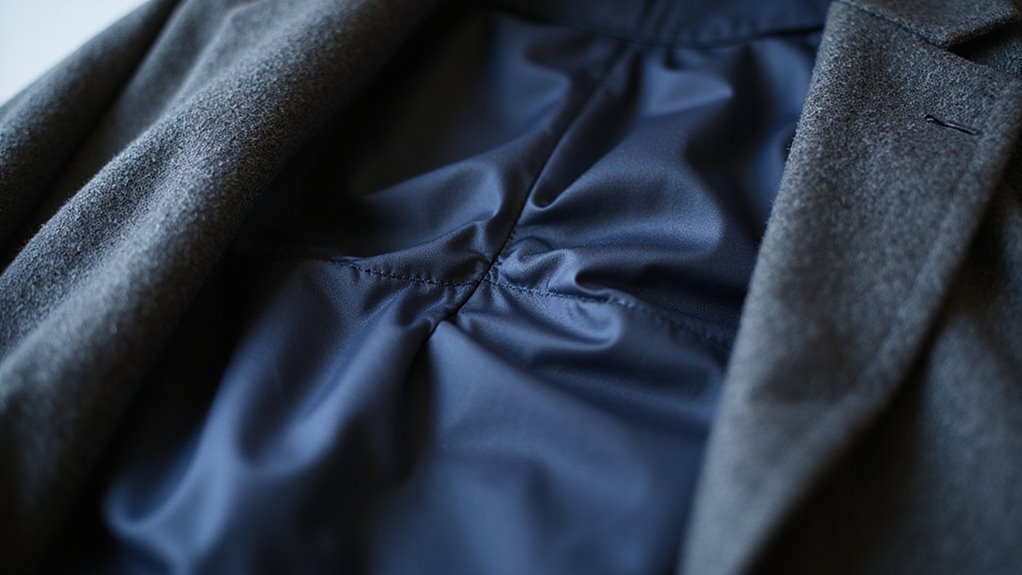
A suit jacket lining is the fabric inside a suit jacket. It adds comfort and helps the jacket keep its shape. Most linings have a smooth and shiny look because of special dyeing methods. The thickness of the lining affects how the jacket fits and feels. Thicker linings make the jacket feel heavier and more structured. Thinner linings keep the jacket light and flexible.
Common materials for linings include silk, acetate, and viscose. If you choose a certain material, you may notice a difference in comfort and appearance. The construction, color, and thickness of the lining are important details. These features can change both the style and feel of your jacket.
Many designers use custom jacket lining mockups to visualize and experiment with different lining options before finalizing their designs. Mockups serve as essential tools to test and refine design elements such as lining before the jacket is produced, ensuring the best possible outcome for both style and comfort.
Key Functions of Jacket Linings
When you choose a jacket lining, you’re shaping how the suit feels on your skin, moves with your body, and adapts to changing temperatures. The right material improves comfort, reinforces the jacket’s silhouette, and manages airflow for climate control. Your decision directly impacts the balance between structure, breathability, and overall wearability.
Selecting the lining material also affects maintenance and durability, ensuring your jacket stays comfortable and looks sharp over time. Using a high-quality mockup can also help you visualize how different linings will look and drape within your suit, aiding in a more confident and informed selection.
Comfort and Wearability
Comfort and wearability depend on the jacket lining’s material and construction. The lining touches your skin, so it should feel smooth. Fabrics like silk, Bemberg, or fine viscose are good choices. These materials help your skin breathe and wick away sweat.
Soft linings also prevent irritation if you wear the jacket for many hours. Neatly finished seams and smooth surfaces stop chafing and bulky spots. If you pick matching colors for the lining and outer fabric, you may feel more confident. A well-chosen lining can make the suit feel more comfortable and personal.
Structure and Shape
The lining helps the suit jacket keep its shape and structure. It stops the jacket from sagging or losing its clean lines. If you choose a smooth lining, the jacket will fit better over your shirt. Good linings, like Bemberg or silk, also make the jacket look tidy inside. They cover up the seams and padding so nothing shows through the fabric. The right lining will make the jacket drape well and keep its sharp look.
- The lining keeps the shoulders and lapels firm.
- It hides stitching and padding inside the jacket.
- It helps the jacket hang smoothly and keeps the outer fabric in good shape.
If you want your jacket to last, pick a lining that looks good and supports the structure.
Breathability and Climate
The lining affects how comfortable your suit feels in different weather. Lightweight linings like Bemberg or cupro allow air to flow. These are good choices if you live in a hot climate or wear your suit for long hours. Thicker linings, such as polyester blends, help keep you warm in cold weather.
If you need a summer suit, choose a lighter lining. For winter, pick a heavier one. You should also think about how the lining feels on your skin. If you match the lining to your needs, your suit will feel comfortable in any climate.
Full Lining vs. Partial Lining vs. Unlined Jackets
A jacket’s lining can be full, partial, or unlined. This choice affects how the jacket feels, looks, and breathes. Full linings cover the whole inside and give the jacket a smooth shape. Partial linings cover only some areas, like the back or sleeves, to make the jacket lighter and cooler.
Unlined jackets have no extra fabric inside, so they feel light and show the jacket’s inner details. Suit presentation can be enhanced by using high-resolution visuals to better highlight how the lining choice impacts the overall look.
- Full lining gives the most structure and makes the jacket easy to wear.
- Partial lining offers a good mix of support and airflow for mild weather.
- Unlined jackets work well in hot weather and look more relaxed.
When designing or presenting jacket options, high-quality mockups can visually demonstrate how different linings affect the jacket’s drape and overall appearance.
Common Lining Materials Explained
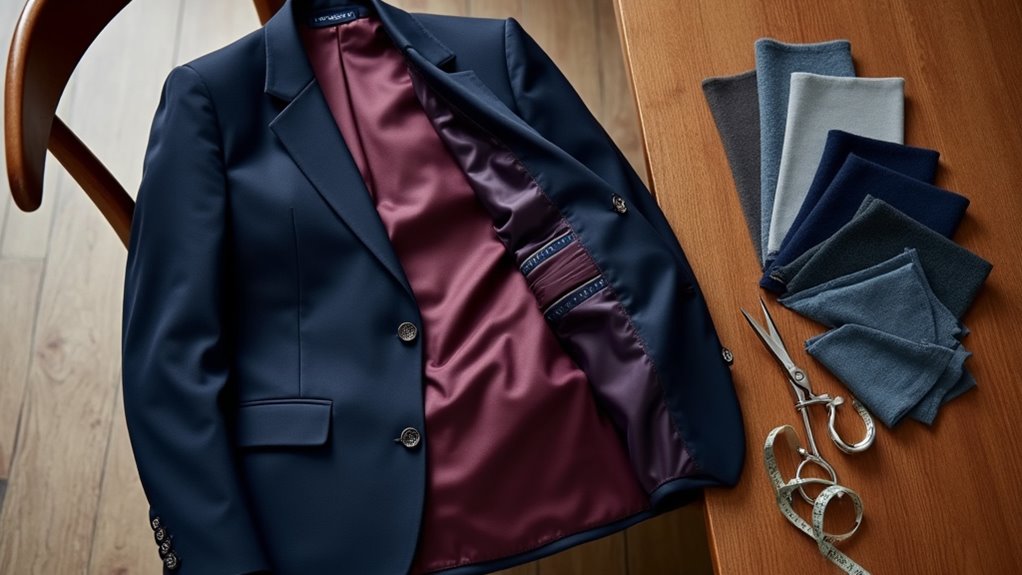
When you choose a suit jacket lining, you’ll notice options like pure silk and advanced synthetics, each offering distinct advantages. You’ll want to weigh factors such as breathability, tactile comfort, and how well the fabric resists wear over time. Let’s break down the visual qualities, maintenance needs, and durability of the most common lining materials.
Just as realistic preview mockups help visualize product designs before production, understanding the specific properties of each lining material can guide you toward the right choice for both style and function. When selecting a lining, considering mockup benefits can help you make more informed decisions about comfort, durability, and appearance before moving into full production.
Silk vs. Synthetic Linings
Suit jacket linings are usually made from silk or synthetic fabrics. Silk linings look shiny and feel smooth. Synthetics like polyester, viscose, or acetate are cheaper and wrinkle less. Silk makes a suit look more elegant and is good for custom pieces. Synthetic linings last longer and keep their color well.
If you want a fancy look, pick silk. If you need something strong and affordable, choose synthetic. The lining can also affect how the jacket holds its shape and shows off details. If you care about how accessories look, consider how the lining matches them.
Breathability and Comfort Factors
The lining material affects how comfortable your suit feels all day. Bemberg is a good choice for airflow and moisture control. Silk feels soft but can get hot and trap heat.
Polyester is common but often feels stuffy due to poor breathability. If the lining is dyed dark, it may block airflow even more. Proper tailoring helps the lining stay smooth and allows better air movement. Knowing these facts helps you pick a lining that keeps you cool during long or warm days.
Durability and Maintenance Tips
Suit jacket linings need proper care to last longer. Daily friction and cleaning can wear down the material. Poor dye quality can cause color to bleed or fade. Tight, even stitching helps prevent seams from fraying. Each fabric—viscose, polyester, or silk—needs its own care routine.
- Spot clean stains right away by blotting, not rubbing.
- Repair loose lining stitches as soon as you notice them.
- Only dry clean when needed, as too much cleaning can weaken the lining.
Silk Linings: Pros and Cons
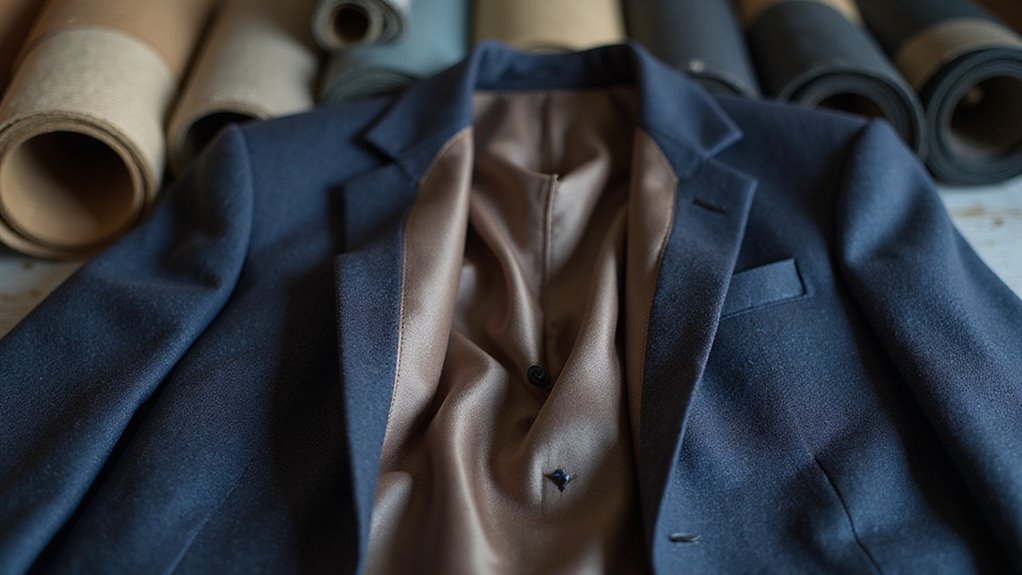
Silk linings are known for their luxury and smooth feel in suit jackets. They look shiny and feel soft against the skin. Silk helps regulate temperature, so it keeps you cool in summer and warm in winter. If you want comfort and style, silk is a good choice. However, silk is delicate and can wear out quickly with daily use. The fibers may weaken with sweat or moisture. You will need to care for silk linings often.
If durability is important to you, silk may not be the best option. Silk works well for special occasions but is less practical for everyday wear. Silk linings are often chosen for bespoke craftsmanship in high-end, custom-tailored suit jackets, adding a touch of sophistication and luxury to the garment. In the fashion industry, silk linings can play a role in visual storytelling by enhancing the overall presentation and perceived value of a suit jacket.
Bemberg and Cupro: The Luxury Synthetic Options
When you want refined performance without pure silk, look to Bemberg and cupro linings. You’ll notice Bemberg’s signature smoothness and anti-static finish, while cupro stands out with exceptional breathability and moisture control. Both materials offer a polished drape and tactile luxury that enhance your jacket’s interior.
For those interested in garment interiors, exploring high-quality mockups can provide designers a closer look at how different linings influence the overall presentation and appeal of apparel. Compared to standard synthetics, Bemberg and cupro are preferred in bespoke suits for their superior comfort and craftsmanship.
Bemberg’s Unique Fabric Qualities
Bemberg fabric is known for its smooth feel and technical qualities. It is made from regenerated cellulose fiber. Bemberg is soft, resists static, and feels comfortable against the skin. Its fine weave helps protect the jacket by reducing friction with the outer fabric. The fabric’s surface shows bright, even colors when dyed. If you want a lining that stays smooth and looks sharp, Bemberg is a strong choice.
- Bemberg’s smooth texture keeps the jacket’s shape intact.
- Its antistatic property stops the lining from sticking to clothes.
- The fiber’s dye process gives deep, clear colors to suit many styles.
If you want a durable and stylish lining, consider choosing Bemberg.
Cupro’s Breathability Advantages
Cupro is known for its excellent breathability. It allows air to move easily through the fabric. This helps prevent heat and moisture from building up inside your jacket. If you wear your jacket for long hours or in different climates, Cupro keeps you comfortable.
The fabric has a smooth finish with a gentle shine, making it look refined. Its light weight keeps your suit jacket looking sharp and prevents extra bulk. Cupro linings also help pockets keep their shape. If you want both comfort and style, Cupro is a smart choice for your tailored clothing.
Polyester Linings: What to Know
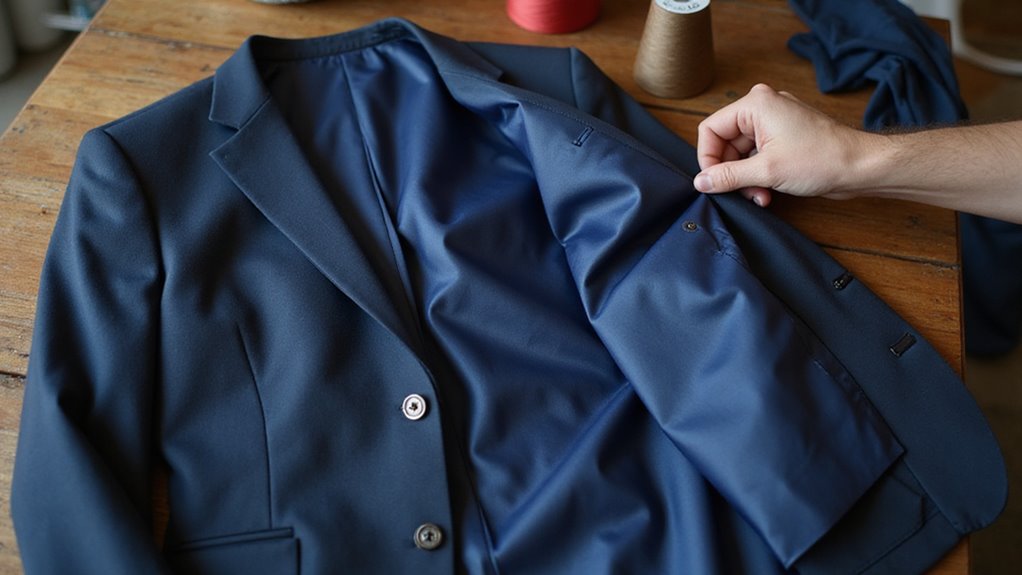
Polyester linings are a common and affordable choice for suit jackets. They are strong, resist wrinkles, and last a long time. The smooth texture feels comfortable and keeps its neat look after many wears. Polyester linings do not pill or snag easily, so they stay looking new. These linings have a shiny finish and keep colors bright.
If polyester linings are washed at home, it’s best to use mild detergent and gentle cycles, which helps maintain their durability and appearance. Polyester is lightweight, so jackets stay slim and easy to wear. The fabric does not soak up moisture, helping you stay dry. You can machine wash or dry clean polyester without damaging it.
If you want a practical and long-lasting lining, polyester is a good option. Polyester linings are popular in clothing because their performance and durability are similar to the benefits found in widely-used digital file formats like PSD, which are valued for flexibility and longevity.
Viscose and Rayon Linings
Viscose and rayon linings feel softer and smoother than most synthetic linings. These materials have a gentle, silk-like drape. Both are made from plant fibers, not plastic. If you want a lining that looks and feels refined, choose viscose or rayon. The surface is shiny and fine, unlike the rougher feel of polyester.
Their texture gives suits a more elegant and subtle look. Both linings are medium in weight, so jackets keep their shape but don’t feel heavy. If you check the inside of a jacket, viscose or rayon means careful material choice. Choosing linings like viscose and rayon reflects the evolution of women’s suits, where comfort and style meet innovative material choices for modern tailoring.
Performance and Breathability Considerations
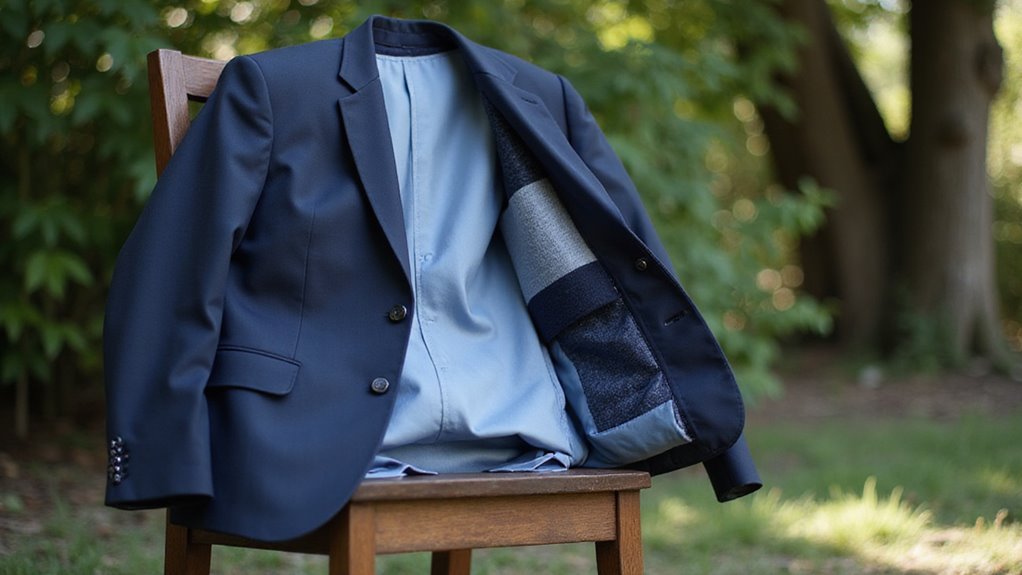
A jacket’s lining affects how comfortable and cool you feel. Different materials handle breathability and moisture in various ways. Lightweight linings like Bemberg or cupro let air move and help sweat evaporate. These are best for warm weather or active use. Heavy linings trap heat, while lighter ones allow better airflow. If you pick a light-colored lining, it can look sharp and stay cooler in sunlight.
Natural fibers or technical blends give the best breathability. You should match the lining’s weight to your climate. Lining colors can highlight your style or make you feel cooler. If you balance these factors, your jacket will feel better and work well.
How Lining Affects the Fit and Drape
Lining affects both the fit and drape of a jacket. A full lining adds weight and helps the jacket keep its shape. Partial or no lining makes the jacket lighter and easier to move in. Structured linings give the jacket a crisp outline. Fabric choice matters.
Silk linings work well with light wool for smooth movement. Synthetic linings suit heavy fabrics and help keep the jacket neat. Natural linings need gentle care, but synthetics can handle more washing. The right lining keeps seams stable and the jacket sitting well on your shoulders. If you choose carefully, the jacket will look good and last longer.
Style and Pattern Choices for Linings
You can select a classic solid color lining for a streamlined, traditional look, or opt for bold patterns that introduce visual contrast and personality. Material choice affects how patterns and colors appear, so pay attention to fabric sheen and texture. For a unique touch, you might consider personalized monogram options that integrate seamlessly with your chosen lining style.
Classic Solid Color Linings
Classic solid color linings are a popular and timeless choice for suit jackets. These linings create a clean and simple look. Solid colors help the jacket appear more refined and elegant. If you want a subtle style, choose navy, charcoal, or black linings. These shades match most suit fabrics and look professional.
Lighter shades like silver or deep blue can add quiet personality. Burgundy is another classic option if you want a bit of color. High-quality materials, like Bemberg or silk, make the lining more comfortable and durable. If you prefer a classic and neat jacket, solid linings are a reliable option.
Bold Patterned Statements
Bold patterned linings let your suit jacket show more personality. Choose a lining with prints like paisley or geometric shapes. If you pick a bold lining, check the fabric type. Satin linings make bright prints stand out, while matte fabrics look softer. Always match the lining color with your suit’s main color.
A bold lining should work well with the jacket, not fight it. If your suit is neutral, high-contrast linings look best. Subtle patterns match better with colorful suits. Make sure the lining fits your style and the event. If you want both style and comfort, focus on fabric and color harmony.
Personalized Monogram Options
Personalized monogram options let you add your initials or designs to your suit jacket lining. This custom touch makes your jacket unique and personal. You can choose embroidery for the inside pocket or the edge of the lining. Material is important—silk and quality viscose work best for clear embroidery.
Select a thread color that stands out or matches your lining. Pick a letter size and font that are easy to read. Place monograms where they are comfortable and still look good. If you want a jacket that is truly yours, personalized options are a great choice.
Matching Lining to Suit Fabric
To match lining to suit fabric, consider color, thickness, and texture. Choose a lining color that complements or contrasts the suit. Navy suits work well with silver or burgundy linings. Charcoal suits look best with blue or black linings. Use lightweight linings like Bemberg or silk for fine wool suits.
If the suit is tweed or flannel, select thicker linings for added support. Always check that the lining’s texture matches the suit fabric. If the lining feels rough, it may cause discomfort. A well-chosen lining improves both comfort and appearance.
Lining Maintenance and Durability
The lining of a suit jacket needs regular care for it to last. Lining faces constant friction and absorbs sweat and oils. If you clean it often, you prevent dirt and damage to materials like silk or viscose. Always check seams and areas that wear out quickly. If you see damage that cannot be fixed, replace the lining. Good maintenance includes these steps:
- Brush your jacket and let it air out after each use.
- Clean stains right away with a mild fabric cleaner.
- If odors or damage remain, seek professional cleaning or replace the lining.
Proper care keeps your jacket comfortable and looking good.
Tips for Choosing the Right Lining for Your Lifestyle
To choose the right lining, focus on how the material suits your daily activities. Breathable linings like Bemberg or cupro are best for active use. These linings help manage sweat and reduce rubbing. For special occasions, silk or viscose linings give a smooth look and feel. They also follow fashion trends for comfort and style.
Consider your local weather and where you spend most of your time. Unlined or half-lined jackets increase airflow in hot places. Full linings add warmth and strength in cold seasons. Pick a lining that matches your movement needs, outfit colors, and how much care you can give. If you match the lining’s features to your lifestyle, you get comfort and a good look.
Conclusion
If you want the best suit experience, you should pay close attention to the lining. The right lining material affects comfort, breathability, and style. If you choose wisely, your suit will feel better and last longer.
When you select a lining, you should consider the climate, your daily activities, and your personal taste. If you live in a warm area, you might prefer breathable Bemberg. If you want extra durability, polyester could be your best option.
If you are ready to customize your suit, you should try the Custom Mockup tool. This tool helps you visualize different linings and colors before you decide. Start your design now and ensure your next suit is both comfortable and stylish.



No Comment! Be the first one.